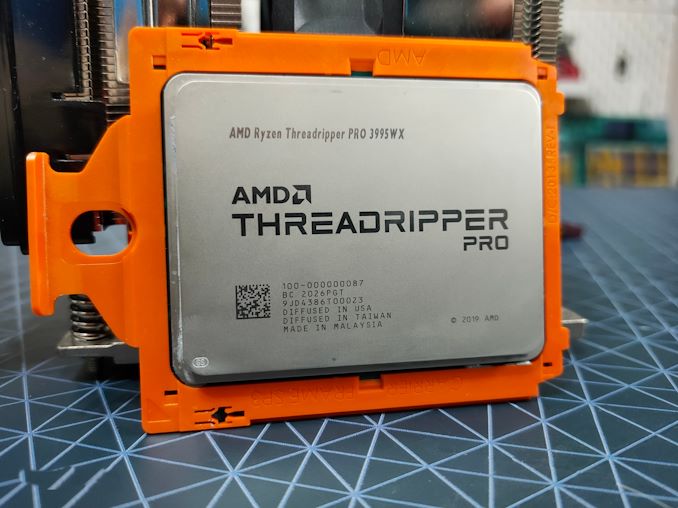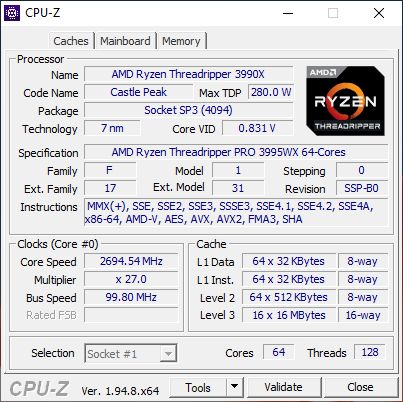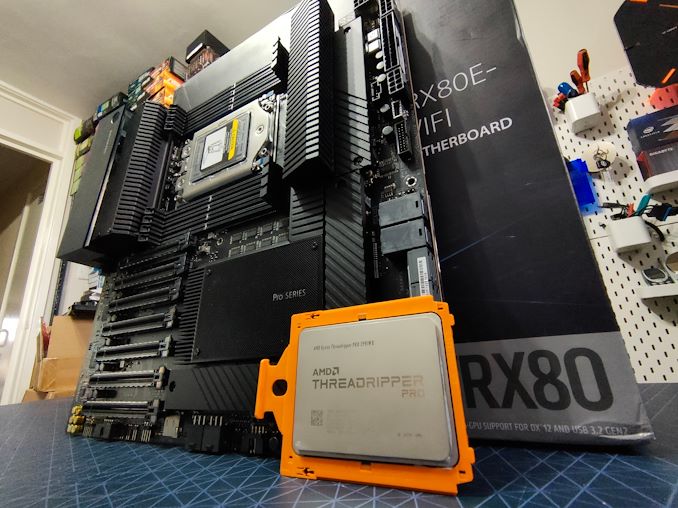AMD Ryzen Threadripper Pro: Retail Offering Starts Today
by Dr. Ian Cutress on March 2, 2021 9:30 AM EST
Today AMD is officially going to start offering its Ryzen Threadripper Pro processors at retail, effectively ending the exclusivity deal with Lenovo on the product line. To date, Lenovo is the only company to have offered Threadripper Pro in the Thinkstation P620 platform. In the past few months, beginning with the CES trade show, we have seen three motherboard manufacturers showcase models of compatible motherboards for the retail market, and today is supposed to be the day that systems with those motherboards can be purchased.
At the launch of the Threadripper Pro platform, AMD advertised four different models from 12 cores up to 64 cores, built upon its Zen 2 architecture and mirroring the Threadripper 3000 family of hardware. The Pro element is an upgrade, giving the processor eight memory channels rather than four, support for 128 PCIe 4.0 lanes, support for up to 2 TB of ECC memory per CPU, and Pro-level admin tools. In essence, sometimes it is easier to think of Threadripper Pro more as ‘Workstation EPYC’, as these new processors are aimed at the traditional workstation crowd.
| AMD Ryzen Threadripper Pro | |||||||
| AnandTech | Cores | Base Freq |
Turbo Freq |
PCIe 4.0 |
L3 Cache |
DDR Cap |
Price SEP |
| 3995WX | 64 / 128 | 2700 | 4200 | 128 | 256 MB | 2 TB | $5490 |
| 3975WX | 32 / 64 | 3500 | 4200 | 128 | 128 MB | 2 TB | $2750 |
| 3955WX | 16 / 32 | 3900 | 4300 | 128 | 64 MB | 2 TB | $1150 |
| 3945WX | 12 / 24 | 4000 | 4300 | 128 | 64 MB | 2 TB | * |
| *Special OEM model | |||||||
| TR 3990X |
64 / 128 | 2900 | 4300 | 64 | 256 MB | 256 GB | $3990 |
| EPYC 7702P |
64 / 128 | 2000 | 3350 | 128 | 256 MB | 4 TB | $4425 |
Out of the four processors, only three are being made at retail – that final 12-core processor is going to remain for specific OEM projects only. Pricing for these units is also being announced today, with the 64-core model sitting at $5490, the 32-core model at $2750, and the 16-core model at $1150.
These prices are larger than the equivalent Threadripper processors by up to 40%, despite our benchmarks showing the difference between the 64-core parts actually around 3% on average. This is because of all the extra features that Threadripper Pro brings to the table.
Motherboards from three manufacturers will be made available: the Supermicro M12SWA-TF, the GIGABYTE WRX80-SU8-IPMI, and the ASUS Pro WS WRX80E-SAGE SE WiFi. Prices for these motherboards are currently unknown, however we did have a short hands on with the ASUS motherboard which you can find in the link below.
- AMD Opens Up Threadripper Pro: Three New WRX80 Motherboards
- Hands-On with the ASUS Pro WS WRX80E-SAGE SE WiFi
We have already reviewed both the Threadripper Pro 3995WX and the Lenovo ThinkStation P620, which you can find here:
- 64 Cores of Rendering Madness: The AMD Threadripper Pro 3995WX Review
- Lenovo ThinkStation P620 Review: A Vehicle for Threadripper Pro
Exactly where and when these CPUs will start at the usual retail places is unclear - we do know that system integrators have been developing configurations with the hardware for several weeks now, so we might see these parts first hit the pre-built area before going fully retail.
We are hoping to get review units for the other CPUs in later this month, along with a few of these motherboards.
Update 1: Scan in the UK is currently selling the 64-core (£5000) and 32-core (£2500), with the 16-core (£1050) on preorder. They also have the ASUS motherboard for sale for £890.












29 Comments
View All Comments
Operandi - Tuesday, March 2, 2021 - link
Good to see AMD making good margins but damn those are expensive... Luckily this isn't something I have a use for so I wouldn't even want such a thing.Random aside those Asus Pro boards are thing of beauty.
romrunning - Tuesday, March 2, 2021 - link
Those boards look like what "Pro" used to mean - beefier system parts & no bling - all business!ArcadeEngineer - Tuesday, March 2, 2021 - link
It might be 'pro' aesthetic rather a 'gamer' aesthetic but you're still paying for the aesthetic either way.Operandi - Tuesday, March 2, 2021 - link
In the sense that it exists and thus has aesthetic and if you want one you have to pay for it?The point being aside from anodizing the heatsinks black there isn't anything on a board like this that isn't functional. In other more direct terms, none of the frivolous useless shit you see on gaming hardware.
ArcadeEngineer - Tuesday, March 2, 2021 - link
Making the PCB black is frivolous. Putting those blocky heatsinks on rather than smaller properly functional fins is frivolous. The fixed rear IO is frivolous. If it was purely functional it'd look like a server board.kgardas - Tuesday, March 2, 2021 - link
Don't think so. In server you usually do have much faster air flow than in workstation which is expected to sit next to engineer desk hence need to be enough quiet to not distract engineer's thoughts. This also mean that workstation board needs to be more carefully cooled by heatsink(s) than server board hence its look must be a bit different.Operandi - Tuesday, March 2, 2021 - link
Get a clue.... this is a board that probably has hundreds of dollars in VRM components alone. Coloring the PCB black costs next to nothing, probably can't even measure it terms of cost of a single board. The fixed IO costs next to nothing and there is no more material costs, just an insignificant amount of design and assembly that adds useful functionality.And those heatsinks; thats what they should look like for passive cooling.
Dolda2000 - Wednesday, March 3, 2021 - link
Using black soldermask may not *cost* anything extra, but it is less functional. It's not exactly unheard of that following traces can be useful when debugging a problem, and black soldermask makes that much harder than standard green soldermask.Abe Dillon - Wednesday, March 3, 2021 - link
I've never heard of anyone following traces on a workstation motherboard to debug a problem. When was the last time you ever heard of that? You think the people who use these things would opt to void their warranty instead of RMA a defective board?Dolda2000 - Wednesday, March 3, 2021 - link
There are such things as using the board second-hand or after the end of the warranty period.